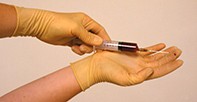Peer Reviewed
Feature Article Occupational health
Infectious risks to healthcare workers
Abstract
Exposure to pathogens that may be transmitted to healthcare workers may be accidental, such as needlestick injuries, or incidental in the course of daily work practice. Infection control precautions and preventive measures are the key to reducing the risk of acquiring infections through occupational exposure.
Key Points
- A number of infectious diseases are now virtually preventable by vaccination. These include hepatitis B and varicella.
- Following a course of hepatitis B vaccination, the serological status of an exposed healthcare worker should be checked. If positive, no further action is necessary (currently, no boosters are recommended).
- Most percutaneous exposures to blood can be prevented by education and basic measures such as not resheathing needles and the appropriate disposal of ‘sharps’.
- Following a needlestick injury, specific prophylaxis in relation to HIV may be necessary. Specialist advice (either via a needlestick hotline or from a teaching hospital) is recommended.
- A number of infections that are spread by direct contact, such as those caused by Staphylococcus aureus, herpes simplex virus and hepatitis A virus, can be prevented by standard universal precautions such as routine handwashing and wearing of gloves.
- Ongoing reinforcement of infection control measures is vital in avoiding occupational exposures to infections.
Purchase the PDF version of this article
Already a subscriber? Login here.

